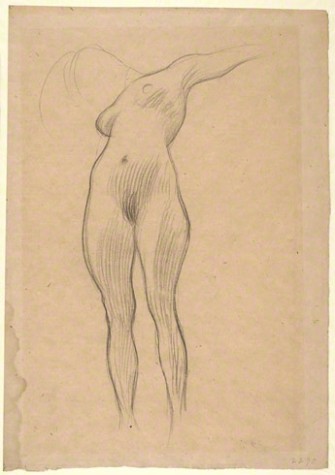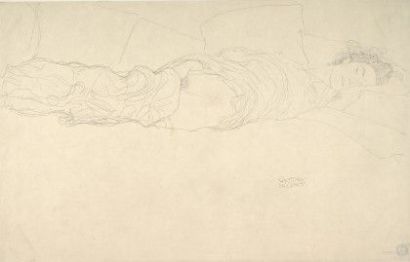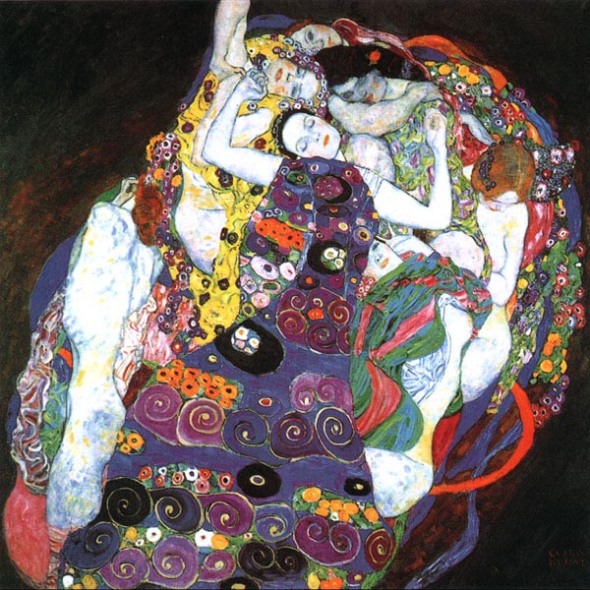1. Historicism and Early Symbolism (1882–1892)
This chapter surveys the years from the last phase of Klimt’s studies at the Kunstgewerbeschule to the crisis year of 1892 in which he lost his younger brother Ernst, with whom he had closely collaborated, and his father. Highlights of this group are the head and figure studies for the Burgtheater paintings and the spectacular 
Allegory of Sculpture, which already heralds the artist’s transition to Symbolism.
2. The Turn to Modernism and the Secession (1895–1903)
With his contribution to Allegorien, Neue Folge, Klimt professed his faith in Symbolism publically for the first time. In 1897, he was appointed president of the newly founded Secession. The works presented in this section include Gustav Klimt‘s illustrations for Ver Sacrum, portraits of anonymous sitters, as well as numerous studies for his faculty paintings Philosophy, 
Medicine,
and Jurisprudence and the Beethoven Frieze. His studies for portraits of women of Viennese society, a genre newly developed by the artist, constitute a group of its own.
3. The Golden Style (1903–1908)
Parallel to his work on his paintings in the Golden Style, Klimt’s creativity as a draftsman reached a culmination in these years. Around 1904, the artist switched from black chalk on wrapping paper to graphite pencil on Japan paper. In the context of his studies for Water Snakes I and 
II he thematized the taboo topics lesbian love and autoeroticism for the first time. This chapter of the presentation highlights the studies for pregnant women in Hope I and II, The Three Ages of Woman, The Kiss, “Fulfillment” and “Expectation” in the Stoclet Frieze, Judith II (Salome), and the first version of Death and Life. A series of studies for various portrait paintings are shown next to various autonomous, painterly portrait drawings.
4. The Late Years (1910–1918)
From 1910 on, Klimt increasingly focused on erotic themes in his work as a draftsman. He not only made entire series of studies for his major works 
The Virgin 
and The Bride,
but also numerous autonomous drawings.
The studies for portraits of women, for which he received many commissions in those years, occupy an important place. Concentrating on specific types, Klimt also dedicated himself to half-length and head-and-shoulder portraits of anonymous female sitters.
The Cooperation with the J. Paul Getty Museum in Los Angeles
After the presentation in the Albertina, a large part of the works, complemented by a number of important loans, will be shown in the J. Paul Getty Museum in Los Angeles, which will not only base its exhibition on the Albertina’s concept, but also use the English version of its catalogue. This will be the first exhibition dedicated to Gustav Klimt on the West Coast.
Biography Gustav Klimt
1862 Gustav Klimt is born on 14 July the son of the gold engraver Ernst Klimt in Baumgarten near Vienna.
1876–83 At the age of 14, Klimt is enrolled at the Vienna School of Arts and Crafts; he is supposed to become a drawing teacher, like his younger brother. After two years, he switches to the decorative painting course; his most important teacher is Professor Ferdinand Laufberger.
1879 Together with Franz Matsch, the Klimt brothers establish and share a studio that operates successfully under the name of Künstler-Compagnie [The Company of Artists]. In 1882/3, they start their collaboration with the architects Ferdinand Hellmer and Hermann Helmer, who are engaged in the design of theatre buildings across the monarchy.
1886–88 The Künstler-Compagnie has sweeping success with the ceiling paintings in the right-hand grand staircase at the Vienna Burgtheater.
1890/1 The decoration of the staircase in the Kunsthistorisches Museum in Vienna turns out to be the Künstler-Compagnie’s last great triumph.
1892 After the death of his father and that of his brother Ernst, Klimt experiences a personal and creative crisis. He takes an increasing interest in Symbolism.
1894 Klimt and Matsch are commissioned to decorate the ceiling in the Great Hall of the University of Vienna with allegories depicting the arts and sciences. Klimt devotes himself to the disciplines of philosophy, medicine, and jurisprudence. View more nice paintings of Gustav Klimt at www.paintingsframe.com.
1897 Klimt is elected president of the newly founded Vienna Secession.
1898 Klimt designs the poster for the Secession’s first exhibition and produces numerous illustrations for the periodical Ver Sacrum.